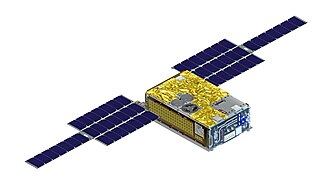
A CubeSat is a class of small satellite with a form factor of 10 cm (3.9 in) cubes. CubeSats have a mass of no more than 2 kg (4.4 lb) per unit, and often use commercial off-the-shelf (COTS) components for their electronics and structure. CubeSats are deployed into orbit from the International Space Station, or launched as secondary payloads on a launch vehicle. As of December 2023, more than 2,300 CubeSats have been launched.

The Italian Space Agency is a government agency established in 1988 to fund, regulate and coordinate space exploration activities in Italy. The agency cooperates with numerous national and international entities who are active in aerospace research and technology.

The Luigi Broglio Malindi Space Center (LBMSC) located near Malindi, Kenya, is an Italian Space Agency (ASI) Spaceport. It was named after its founder and Italian space pioneer Luigi Broglio. Developed in the 1960s through a partnership between the Sapienza University of Rome's Aerospace Research Centre and the National Aeronautics and Space Administration (NASA), the BSC served as a spaceport for the launch of both Italian and international satellites (1967–1988). The center comprises a main offshore launch site, known as the San Marco platform, as well as two secondary control platforms and a communications ground station on the mainland.

The Institute of Space Technology is a public university located in Islamabad, Pakistan. It is focused on the study of astronomy, aerospace engineering, avionics engineering, Computer science , Artificial intelligence, Data science and astronautics.
The development of Ugandan space initiatives has been largely shaped by that country's position on the equator. Its history is marked by an early involvement in issues of space law, and in 2022 by the launch of its first satellite, PearlAfricaSat-1.

The Space & Upper Atmosphere Research Commission, commonly referred to as SUPARCO, is the national space agency of Pakistan.

The South African National Space Agency (SANSA) is South Africa's government agency responsible for the promotion and development of aeronautics and aerospace space research. It fosters cooperation in space-related activities and research in space science, seeks to advance scientific engineering through human capital, as well as the peaceful use of outer space, and supports the creation of an environment conducive to the industrial development of space technologies within the framework of national government.
National Authority for Remote Sensing and Space Sciences (NARSS) is the pioneering Egyptian institution in the field of satellite remote sensing and space sciences.
The Algerian Space Agency, was established on January 16, 2002 in Bouzareah, Algiers. The agency is in charge of the Algerian space program, and has flown five different satellites.
The space programme of Kenya has been largely shaped by Kenya's equatorial latitude, and has basis of existed foreign infrastructure and experience. The development of the programme started in May 2012.

PhoneSat is an ongoing NASA project of building nanosatellites using unmodified consumer-grade off-the-shelf smartphones and Arduino platform and launching them into Low Earth Orbit. This project is part of NASA's Small Spacecraft Technology Program and was started in 2009 at NASA Ames Research Center.

The Polish Space Agency is the space agency of Poland, administered by the Ministry of Economic Development and Technology. It is a member of the European Space Agency. The agency is focused on developing satellite networks and space technologies in Poland. It was established on 26 September 2014, and its headquarters are located in Gdańsk, Poland.
The UAE Space Agency (UAESA) is the space agency of the United Arab Emirates government responsible for the development of the country's space industry. It was created in 2014 and is responsible for developing and regulating the space sector in the UAE.

EQUULEUS is a nanosatellite of the 6U CubeSat format that will measure the distribution of plasma that surrounds the Earth (plasmasphere) to help scientists understand the radiation environment in that region. It will also demonstrate low-thrust trajectory control techniques, such as multiple lunar flybys, within the Earth-Moon region using water steam as propellant. The spacecraft was designed and developed jointly by the Japan Aerospace Exploration Agency (JAXA) and the University of Tokyo.

1KUNS-PF was the first Kenyan-owned satellite. The cubesat was developed and assembled by the University of Nairobi for the Kenya Space Agency, with technical support provided by Japan's Aerospace Exploration Agency. The spacecraft was deployed from the International Space Station after being launched by a SpaceX Falcon 9 rocket.
ArmCosmos, commonly known as the Armenian Space Agency, is an Armenian private agency responsible for the development of Armenia's commercial space industry, coordinating domestic activities, identifying opportunities and facilitating international space engagement, on behalf of the Government of Armenia. Its headquarters are located in Yerevan, Armenia.
EnduroSat AD is a Bulgarian aerospace manufacturer headquartered in Sofia. It was founded in 2015 by Raycho Raychev. The company designs, builds, and operates CubeSats and Nanosatellites for commercial and scientific missions and is developing inter-satellite linking and data applications. EnduroSat was nominated as one of the top 5 small satellite start-ups.
The history of space in Africa is the history of space activity by or sent from Africa.
The Taifa-1satellite also capitalized as TAIFA-1 satellite, is a Kenyan earth observation 3U CubeSat, and was launched on 14 April 2023 into space together in a joint collaboration with Exolaunch aboard a SpaceX's Falcon 9 rocket from Vandenberg Space Force Base in California, USA. It is the first satellite launched by Kenya Space Agency that was purely developed by Kenyan engineers with an intensive training provided by EnduroSat. Although the satellite was developed and designed by Kenyan engineers, the manufacturing was solely done by EnduroSat.










